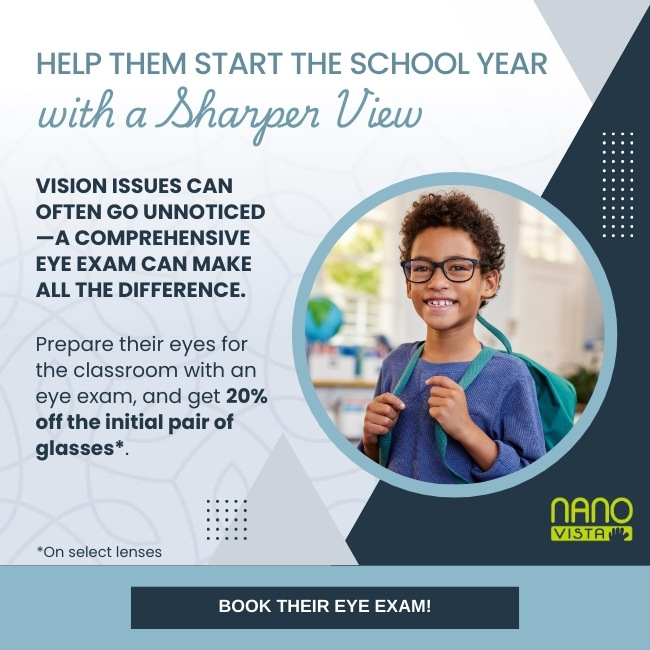Normal vision is seeing objects either far away or close-up clearly because light focuses directly on the retina. If objects look blurry, an eye examination can test your vision and determine your eye health and identify whether you have any eye conditions.
Common eye problems include farsightedness (hyperopia) and nearsightedness (myopia). These are conditions that can occur in both adults and children.
So, what is the difference, and how do you tell which one you have? We explain both conditions, their causes, symptoms, and treatment options.
What Is Nearsightedness?
Nearsightedness is when you can see objects that are closer to your face better than those that are far away. You can read a book easily as it’s closer to you, but reading a sign farther away appears blurry.
Children are usually diagnosed with nearsightedness as it is inherited. The condition can progress in childhood and adolescence as the eyes develop and change shape as they grow. Young children may not know they have vision issues, which makes eye exams crucial for picking these up early.
What is Farsightedness?
Farsightedness is the opposite. You can see far-away objects better than close-up ones. Presbyopia is another form of farsightedness that usually occurs as a natural part of aging and starts around 40 years.
1 in 7 children is diagnosed with farsightedness. If not diagnosed and treated early, children with farsightedness can develop strabismus or crossed eye. This condition is also inherited but can result from developmental issues in early childhood.
Causes of Nearsightedness & Farsightedness
Both nearsightedness and farsightedness are refractive errors. That means light does not focus properly in the retina at the back of the eye.
In nearsightedness, the eyeball is too long, or the cornea is steeply curved. This causes the light to focus in front of the retina rather than on the retina, increases the focusing distance, and objects farther away look blurry.
In farsightedness, the eyeball is too small or short, the cornea is flat or not curved enough, or the focusing power is weak. This causes the light to focus behind the retina rather than directly on it, and objects close up look blurry.
Signs of Nearsightedness & Farsightedness
There is some overlap of symptoms in nearsighted and farsighted individuals. Despite this, you may notice some additional symptoms that differentiate the two. A comprehensive eye exam can help to distinguish one from the other.
Symptoms of nearsightedness include:
- Difficulty with distance work such as playing sports
- Trouble seeing on the white or blackboard
- Headaches
- Squinting
- Eye fatigue
- Eye pain
Symptoms of farsightedness include:
- Difficulty with near work such as reading a book or using the computer
- Squinting
- Headaches
- Eye strain
- Burning
Diagnosing Nearsightedness & Farsightedness
Comprehensive eye exams for adults and children are painless, easy, and can diagnose refractive errors. If you have a family history of these or other eye conditions, regular exams can help detect eye problems early. Diagnosing nearsightedness and farsightedness involves:
- A standard vision test using an eye chart to check visual acuity.
- A retinoscope shines a light in the eye and checks reflection off the retina, indicating if you are nearsighted or farsighted.
- A phoropter measures the refractive error you have for correction.
Treatment for Nearsightedness & Farsightedness
Corrective options for refractive errors depend on your eyes and lifestyle. Eyeglasses and contact lenses are usually the easiest and safest options to correct near and farsightedness.
They offer clear vision by refocusing light on the retina and compensating for eye shape. You will need new glasses or contact lenses as your prescription changes.
Orthokeratology or ortho-k gradually flattens the cornea using hard contact lenses. These hard contact lenses, worn at night, reduce nearsightedness. It works as long as you keep wearing them. When you stop, the cornea reverts to its original shape.
Refractive surgery is another option that uses a laser to reshape the cornea, which adjusts how light travels into the eye and focusing ability. The most common type of refractive surgery is LASIK.
Book Your Next Eye Exam for Clearer Vision
Nearsightedness and farsightedness are two eye conditions that affect your vision. You either see blurry objects at a distance or close up due to the refraction of light through the eye’s lens and the inability to focus on things.
If you notice changes in your vision, early identification and treatment can prevent further damage to your eyes. Call Doctors Eye Care in Grand Prairie to book your next eye exam.




